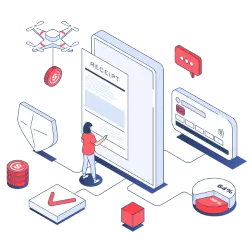If you’re interested in processing electronic payments, you may be wondering about the differences between ACH vs EFT. The truth of the matter is electronic payments are a growing payment method. In 2018, over 5,800 million users worldwide used electronic transfers. So, what are these payment methods, and how do they affect your business? There are a lot of acronyms her,e and it may look confusing. However, the differences between the two are quite simple. Read on to learn about ACH versus EFT, how these compare to a wire, and how ACH EFT payments work.
First Off, What is an ACH Transfer?
ACH stands for “Automated Clearing House,” which is a fancy way of saying a payment that runs through the Automated Clearing House Network. The Automated Clearing House Network is an online network that connects all of the financial institutions in the U.S. so they can transfer money amongst themselves quickly and easily. An ACH transfer is an electronic payment made over the Automated Clearing House Network.
In Q2 of 2021, there was a 9.9% increase in ACH transfer volume, showing that now is a great time to learn about ACH payments.

The benefits of ACH payments

Here are some reasons you should consider offering ACH payment processing in your business:
- Additional Payment Option. One of the major reasons you should consider adding ACH payments to your business is that it offers your customers an additional way to pay. When processing payments virtually (such as online), for example, it’s always better to offer more options.
- Security. Another benefit to the ACH payment is that the transaction is secure, depositing into your bank account quickly with a very low risk of fraud.
- Cost. ACH payments are usually a fraction of the cost of credit card processing.
Now, What is an EFT?
Now that you understand ACH payments, let’s move on to EFT.
EFT is a blanket term that stands for Electronic Funds Transfer. All payments made electronically are technically electronic funds transfers. Differentiating between EFT vs ACH is often confusing, but it doesn’t have to be. EFT is the more general term – an ACH transaction is a type of EFT payment.

The benefits of EFT payments
EFT payments offer many conveniences for businesses than more traditional payment methods like cash or checks. Here are some of the benefits:
- Global Purchasing Power. One major benefit of EFT is that it has connected payments around the world. Considered one of the major technological advancements, it has empowered globalization in a way never before possible.
- Convenience. Processing checks and cash come with many burdens, such as needing to physically go to the bank to make deposits, reconciliation issues due to mistakes made, manual counting processes for issuing change, etc. that EFT payments have largely eliminated.
- Accessibility. Many of your customers quit carrying cash and checkbooks with them long ago. Banks don’t always give checkbooks to account holders unless they specifically request them. This is because paper check technology has become largely outdated.
What is the Difference Between ACH and EFT?
EFT vs ACH: what is the difference between ACH and EFT? As you may have gathered, the difference between the two is not as big as it may initially seem.
EFT is a blanket term covering all electronic payments. Therefore, ACH payments are a type of EFT payment. Despite their similarities, there are also some differences. Let’s look at those next:
- Security. EFT/ACH payments offer enhanced security over other types of EFT transactions (such as credit card payments, for example). Due to the level of scrutiny a transaction undergoes during and before the EFT/ACH transfer, an EFT ACH transaction is harder to compromise (i.e., less likely to be fraudulent) than a credit card transaction.
- Speed. Other types of EFT transactions are much faster than EFT ACH transactions in many cases. For example, a credit card can be processed in seconds and settled within the day. But ACH EFT payments, on the other hand, usually take a few days to process.
- Cost. ACH EFT payments are extremely inexpensive to run compared to other types of EFT payments (such as a credit card).

Types of transfers
ACH vs Wire vs EFT: the types of transfers.
- ACH Transfer: An ACH transfer is a direct transfer between two bank accounts. There is no intermediary needed to process the payments (Zelle is an example of an ACH transfer system).
- Wire Transfer: A wire transfer is very similar to an ACH transfer with one major difference. Banks complete ACH transfers in bulk. These transfers are likely to be processed with other transactions (usually in a NACHA file). A wire transfer, on the other hand, is an individual transaction. It’s designed to be both initiated and completed alone. This makes it more expensive to process a wire transfer.
- EFT Transfer: A standard, non-ACH EFT transfer is an indirect transfer between two bank accounts. There needs to be an intermediary to process the transaction (credit card processing is an example).

The parties involved

In all EFT payments, there are two banks involved: The initiating and the receiving bank. You can think of these as your bank (the receiving bank) and your customer’s bank (the issuing or initiating bank).
Different types of transactions will require different involved parties. For example, credit card processors are a required third party in all credit card transactions.
With EFT/ACH transactions, it’s important to know that there is no intermediary. Because of this, you will not get an immediate response if a transaction declines. Instead, you will usually see an initial deposit and then a reversal if the initiating bank doesn’t have enough funds to make the transfer.
ACH vs EFT: Which Makes Sense for Your Business?
The uptick in electronic payments has been strong for many years. However, the pandemic has led companies and individuals to adopt the technology even faster. Many establishments, at least temporarily, quit accepting cash for sanitary reasons. If you’re looking for a time to start adding electronic payments to your business, now is the perfect time.
There are many types of EFT payments. Types like ACH EFT, credit card processing, direct deposit, eChecks, and more. The right balance for your business will depend on your environment.
If you have recurring business that consistently pays remotely and in high amounts (such as a corporate law firm), a direct deposit or eCheck balance may be right for you. On the other hand, if you have high numbers of one-off or in-person customers (such as an accounting firm or eCommerce store), it may make sense to accept a higher percentage of credit card payments. The right balance for your business and customers is likely somewhere in the middle.






